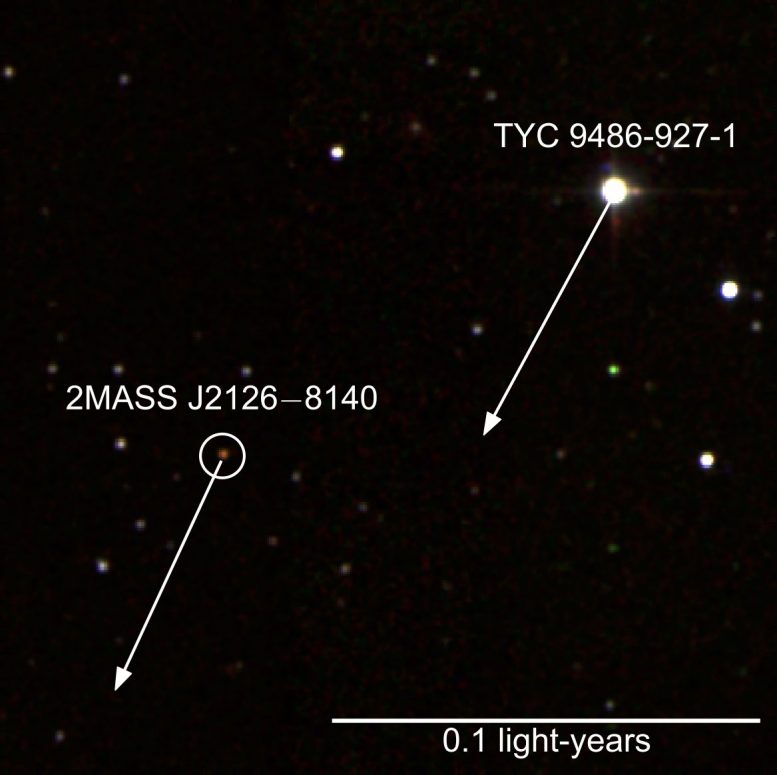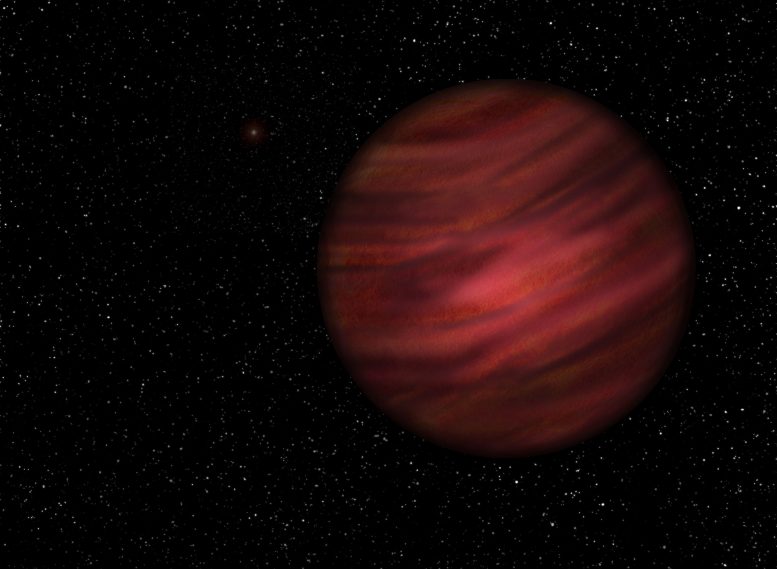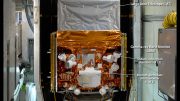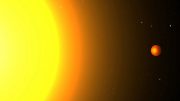New research reveals that planet 2MASS J2126 and the star TYC 9486-927-1 are moving through space together, implying that they are associated.
A team of astronomers in the UK, USA, and Australia have found a planet, until now thought to be a free-floating or lonely planet, in a huge orbit around its star. Incredibly the object, designated as 2MASS J2126, is about 1 trillion (1 million million) kilometers from the star, or about 7000 times the distance from the Earth to the Sun. The researchers report the discovery in a paper in Monthly Notices of the Royal Astronomical Society.
In the last five years a number of free-floating planets have been found. These are gas giant worlds like Jupiter that lack the mass for the nuclear reactions that make stars shine, so cool, and fade over time. Measuring the temperatures of these objects is relatively straightforward, but it depends on both mass and age. This means astronomers need to find out how old they are before they can find out if they are lightweight enough to be planets or if they are heavier ‘failed stars’ known as brown dwarfs.
US-based researchers found 2MASS J2126 in an infrared sky survey, flagging it as a possible young and hence low-mass object. In 2014 Canadian researchers identified 2MASS J2126 as a possible member of a 45 million-year-old group of stars and brown dwarfs known as the Tucana Horologium Association. This made it young and low enough in mass to be classified as a free-floating planet.
In the same region of the sky, TYC 9486-927-1 is a star that had been identified as being young, but not as a member of any known group of young stars. Until now no one had suggested that TYC 9486-927-1 and 2MASS J2126 were in some way linked.
Lead author Dr Niall Deacon of the University of Hertfordshire has spent the last few years searching for young stars with companions in wide orbits. As part of the work, his team looked through lists of known young stars, brown dwarfs, and free-floating planets to see if any of them could be related. They found that TYC 9486-927-1 and 2MASS J2126 are moving through space together and are both about 104 light years from the Sun, implying that they are associated.
“This is the widest planet system found so far and both the members of it have been known for eight years,” said Dr Deacon, “but nobody had made the link between the objects before. The planet is not quite as lonely as we first thought, but it’s certainly in a very long-distance relationship.”
When they looked in more detail, the team were not able to confirm that TYC 9486-927-1 and 2MASS J2126 are members of any known group of young stars.
“Membership in a group of young stars is great for establishing an age,” said study co-author Josh Schlieder of the NASA Ames Research Center, “but when we can’t use that we need to resort to other methods.”

A false color infrared image of TYC 9486-927-1 and 2MASS J2126. The arrows show the projected movement of the star and planet in the sky over 1000 years. The scale indicates a distance of 0.1 light years. Light from the star takes about a month to travel to the planet. Credit: 2MASS/S. Murphy/ANU
The team then looked at the spectrum – the dispersed light – of the star to measure the strength of a feature caused by the element lithium. This is destroyed early on in a star’s life so the more lithium it has, the younger it is. TYC 9486-927-1 has stronger signatures of lithium than a group of 45 million-year-old stars (the Tucana Horologium Association) but weaker signatures than a group of 10 million-year-old stars, implying an age between the two.
Based on this age the team was able to estimate the mass of 2MASS J2126, finding it to be between 11.6 to 15 times the mass of Jupiter. This placed it on the boundary between planets and brown dwarfs. It means that 2MASS J2126 has a similar mass, age, and temperature to one of the first planets directly imaged around another star, beta Pictoris b.
“Compared to beta Pictoris b, 2MASS J2126 is more than 700 times further away from its host star,” said Dr Simon Murphy of the Australian National University, also a study co-author, “but how such a wide planetary system forms and survives remains an open question.”
2MASS J2126 is around 7000 Earth-Sun distances or 1 trillion kilometers away from its parent star, giving it the widest orbit of any planet found around another star. At such an enormous distance it takes roughly 900,000 years to complete one orbit, meaning it has completed less than fifty orbits over its lifetime. There is little prospect of any life on an exotic world like this, but any inhabitants would see their ‘Sun’ as no more than a bright star, and might not even imagine they were connected to it at all.
Reference: “A nearby young M dwarf with a wide, possibly planetary-mass companion” by N.R. Deacon, J.E. Schlieder and S.J. Murphy, 23 February 2016, MNRAS.
DOI: 10.1093/mnras/stw172









Perhaps after a hiatus of 50 years science is returning to the concept of electrically born planets.
Solaria Binaria was only one of many theories that incorporated the factually scarred Earth and historical lore.
And perhaps now serious attention can be given to the fact that populations have historically been shattered by the results.
All star formation are not successful. We know many stars which have failed to become a star had become a gas giant planet, like Jupiter, Saturn etc. This particular so called planet seems to be a failed star and which became an orphaned gas giant. In the cosmos any planet or star or even a galaxy should be gravitationally go about another similar one. Here it is travelling towards a distant star which is its nearby star and hence this paradox of trillion kilometers away from a parent star??.. Thank YOu.